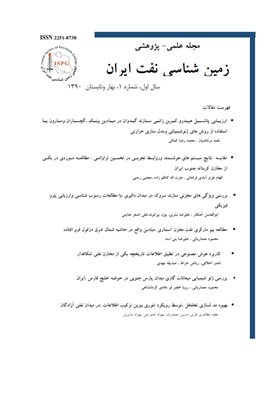مقایسه نتایج سیستم های هوشمند وروابط تجربی در تخمین تراوائی :مطالعه موردی در یکی از مخازن کربناته جنوب ایران
محورهای موضوعی :
کلید واژه: روابط تجربی مخازن کربناته منطق فازی سیستم عصبی-فازی تراوایی ,
چکیده مقاله :
تخمین تراوائی که یکی از مهم ترین پارامتر های پترو فیزیکی مخازن نفت وگاز می باشد ،همواره یکی از چالش های پیش رو ی محققین صنعت نفت بوده است .دقیقی ترین روش برای بدست آوردن این پارامتر ،آنالیز مغزه می باشد اما ،مشکلات تهیه مغزه از یک سو وصرف زمان وهزینه بالا از سوی دیگر ،محققان را بر ان داشته است که ،تراوایی را از روش های غیر مستقیم بدست اورند .از جمله روش هایی که از دیر باز برای محاسبه این پارامتر مورد استفاده قرار گرفته ،روابط تجربی می باشد .اگر چه این روابط در بعضی موارد پاسخ قابل قبولی می دهد ،ولی موارد بسیار زیادی وجود دارد که پاسخ روابط تجربی چندان جالب نیست .از طرفی در سال های اخیر سیستم های هوشمند به عنوان یک روش جدید در پیش بینی وتخمین پارامتر های پترو فیزیکی مورد استفاده قرار گر فته است.در این مطالعه سعی بر این است که توانایی این دو روش (روابط تجربی وسیستم های هوشمند )در یکی از مخازن کربناته ،با استفاده از داده های مربوط به 4 چاه (3 چاه مدل و1 چاه آزمون )مورد بررسی قرار گیرد .برای نیل به این هدف در ابتدا تراوائی با استفاده از روابط تجربی (نظیر رابطه تیمور،تیکسر و....) محاسبه شده ،سپس با استفاده از سیستم های فازی وعصبی-فازی ،مدل تخمین تراوایی در مخزن مورد نظر ساخته می شو ودر بین روش های استفاده شده ،نتایج بدست آمده در مورد سیستم فازی (با ضریب همبستگی برابر با 88/0) قابل قبول تر می باشد .هم چنین در بین روابط تجربی رابطه وایلی-رز بالاترین ضریب همبستگی وکمترین میزان میانگین مربعات خطا را نسبت به بقیه روابط تجربی دارد .با مقایسه نتایج بدست امده ،مدل فازی ساخته شده برای تخمین تراوایی در مخزن مورد بررسی پیشنهاد می گردد .
Prediction of permeability that is one of the most important parameters in oil and gas reservoirs is probably the most challenging issue geologists, petrophysicists, and reservoir engineers have to deal with. This parameter control fluid flow in production stage. The most reliable data of permeability are taken from laboratory analysis of cores. Since coring is a costly and time consuming operation, researchers have tried to predict this parameter from other methods. Empirical equation is one of these methods, but results of these equations are not satisfied for all lithology and reservoirs. So far, several studies have been carried out for the estimation of reservoir parameters using intelligent systems. These studies indicate the successful role of these methods such as fuzzy logic, neuro-fuzzy and genetic algorithms for reservoir characterization. In this study, we try to compare results of these two methods (empirical equations and intelligent systems) for permeability prediction in a carbonate reservoir. For this purpose, petrophysical and core data of four well in a carbonate reservoir in the Southern Iran were used. At first, using empirical equations permeability was calculated for the test well; then using data of three wells, intelligent models were constructed. A forth well (test well) from the field was used to evaluate the models. The results show that fuzzy logic result (with R2= 0.88) is the best method for prediction of permeability in the studied reservoir. Also between empirical equations, result of Wyllie-Rose equation is better than others. Finally we offer the constructed fuzzy model (as a best predictor) for permeability prediction in the studied reservoir.

